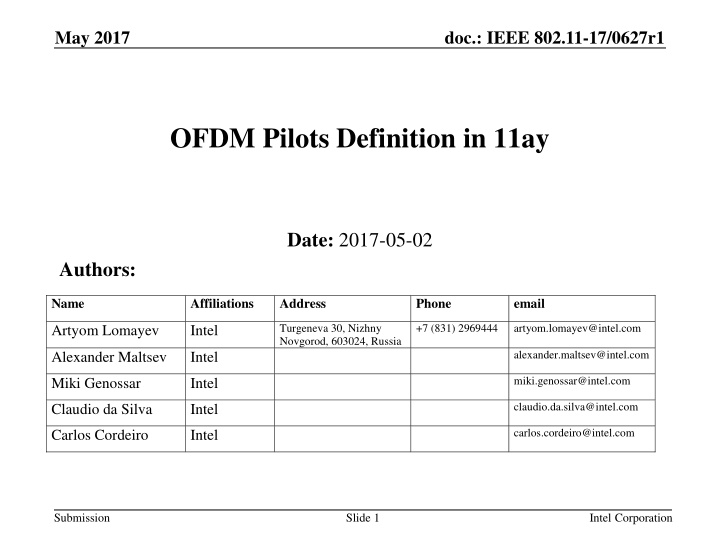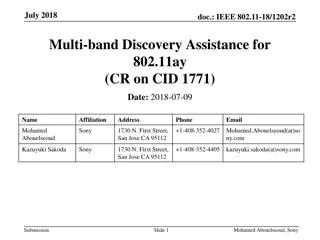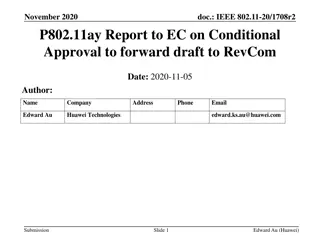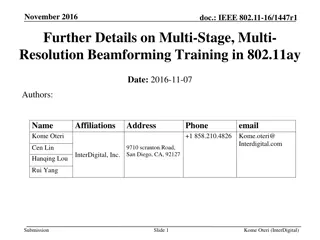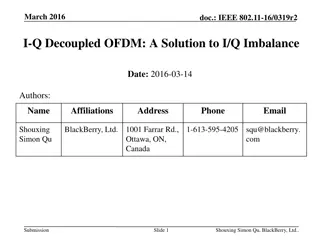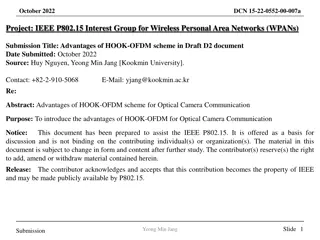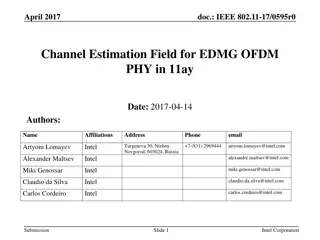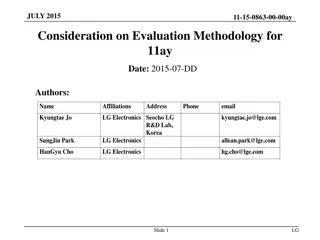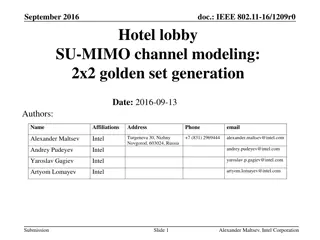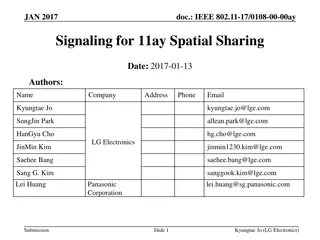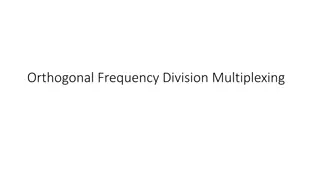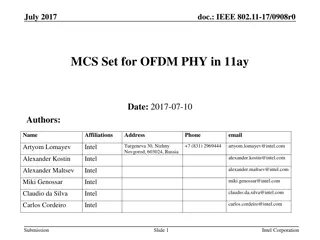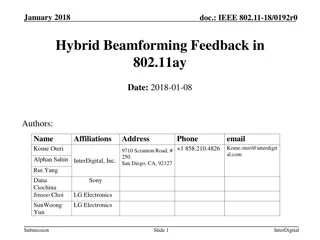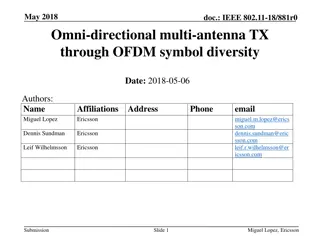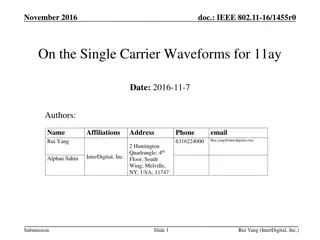IEEE 802.11-17/0627r1 OFDM Pilots Definition in 11ay
This presentation delves into the definition of frequency domain pilots for EDMG OFDM PHY in 11ay, outlining their critical roles in channel estimation, common phase error, and phase noise estimation. It compares pilots in 11ad and 11ay standards, elucidating the space-time stream dependencies and pilot sequence compositions. An example of MIMO transmission with NSTS = 2 is illustrated, showcasing the application of pilot tones in a practical scenario.
Download Presentation

Please find below an Image/Link to download the presentation.
The content on the website is provided AS IS for your information and personal use only. It may not be sold, licensed, or shared on other websites without obtaining consent from the author.If you encounter any issues during the download, it is possible that the publisher has removed the file from their server.
You are allowed to download the files provided on this website for personal or commercial use, subject to the condition that they are used lawfully. All files are the property of their respective owners.
The content on the website is provided AS IS for your information and personal use only. It may not be sold, licensed, or shared on other websites without obtaining consent from the author.
E N D
Presentation Transcript
May 2017 doc.: IEEE 802.11-17/0627r1 OFDM Pilots Definition in 11ay Date: 2017-05-02 Authors: Name Affiliations Address Phone email +7 (831) 2969444 Turgeneva 30, Nizhny Novgorod, 603024, Russia artyom.lomayev@intel.com Artyom Lomayev Intel alexander.maltsev@intel.com Alexander Maltsev Intel miki.genossar@intel.com Miki Genossar Intel claudio.da.silva@intel.com Claudio da Silva Intel carlos.cordeiro@intel.com Carlos Cordeiro Intel Submission Slide 1 Intel Corporation
May 2017 doc.: IEEE 802.11-17/0627r1 Introduction This presentation proposes frequency domain pilots definition for EDMG OFDM PHY in 11ay. Submission Slide 2 Intel Corporation
May 2017 doc.: IEEE 802.11-17/0627r1 Purpose of Pilots Pilots are intended for the following purposes: Channel estimation and tracking; Common phase error (CPE) estimation; Phase noise (PN) estimation; Submission Slide 3 Intel Corporation
May 2017 doc.: IEEE 802.11-17/0627r1 Pilots Definition in 11ad IEEE 802.11ad std. defines 16 pilots uniformly distributed over the OFDM signal spectrum with equidistant step of 20 subcarriers. The pilot sequence P depends on the k-th subcarrier index and n- th OFDM symbol number. The pilot sequence is defined as follows, [1]: P(n, k) = W(n) * P16(k); where: P16 = [ 1, +1, 1, +1, +1, 1, 1, 1, 1, 1, + 1, + 1, + 1, 1, + 1, + 1]; W(n) = 2*p(n)-1, p(n) defines a bit coming from the scrambler, initialized to all ones at first OFDM symbol; Alternatively W(n) can be defined equal to the exponent: W(n) = -exp(-j* *p(n)); Pilot tones have fixed locations with indexes p_idx = [-150:20:150]; Hence, pilot sequence is kept unchanged over the OFDM symbols except of the common phase defined by W(n) multiplier, which can flip from 0 to ; Submission Slide 4 Intel Corporation
May 2017 doc.: IEEE 802.11-17/0627r1 Pilots Definition in 11ay Since 11ay std. defines MIMO transmission, the space-time pilot sequence P(iSTS, n, k) depends on the following variables: iSTS space-time stream number; n OFDM symbol number; k - subcarrier index; Similar to the 11ad case, the pilot tones have fixed locations independent on the space-time stream number iSTS and OFDM symbol n as proposed in [2]. Similar to the 11ad definition, P(iSTS, n, k) can be decomposed as: PNSP(iSTS, n, k) = W(iSTS, mod(n, NSTS)) * (2*p(n) - 1) * PNSP(iSTS, k); PNSP(iSTS, k) defines pilot sequence for given space-time stream number of length NSP = NCB*16 + (NCB-1)*4, [2]; W(iSTS, n) * (2*p(n) - 1) defines common phase shift for given iSTS-th space-time stream and n-th OFDM symbol, p(n) defines a bit coming from the scrambler, initialized to all ones at first OFDM symbol; Submission Slide 5 Intel Corporation
May 2017 doc.: IEEE 802.11-17/0627r1 Example of MIMO with NSTS = 2 Let s consider an example of MIMO transmission with NSTS = 2. Figure below shows two consecutive OFDM symbols represented in frequency domain for iSTS = 1, 2. Matrix W with elements W(iSTS, n) defining the common phase shift per OFDM symbol creates pilots space-time coding: k0-th subcarrier PN(iSTS=1, k=k0) * (+1) PN(iSTS=1, k=k0) * (+1) . . . . . . STS #1 . . . + + OFDM symbol #0 OFDM symbol #1 1 1 = W 2x2 PN(iSTS=2, k=k0) * (-1) + PN(iSTS=2, k=k0) * (+1) 1 1 . . . . . . This channel estimation and tracking. coding allows MIMO STS #2 . . . OFDM symbol #0 OFDM symbol #1 time n = 0 n = 1 Submission Slide 6 Intel Corporation
May 2017 doc.: IEEE 802.11-17/0627r1 Channel Estimation The received vector Y1 for n = 0 and Y2 for n = 1 for given subcarrier k = k0 can be concatenated into matrix Y = [Y1, Y2] and written as follows: ( ) ( ) ( ) ( ) = = = = + = Y H P W Z k k k k k k k k 2x2 2x2 2x2 2x2 2x2 0 0 0 0 ( ) = = ( ) , 1 0 P i k k = = 0 N STS P k k ( ) 2x2 0 = = 0 , 2 P i k k 0 N STS where: H2x2 is a channel matrix, to be estimated, P2x2 is a pilot diagonal matrix, W2x2 is a space-time coding matrix, and Z2x2 is an AWGN matrix, similar to received vector it concatenates vectors [Z1, Z2] for n = 0 and n = 1; The equation above assumes that channel is stationary during certain number of consecutive OFDM symbols. Submission Slide 7 Intel Corporation
May 2017 doc.: IEEE 802.11-17/0627r1 Channel Estimation (Cont d) To get channel estimation one needs to multiply Y2x2 by (P2x2*W2x2)-1 at the right side as follows: ( ) ( ) ( ) ( ) ) ^ 1 = = = = = H Y P W k k k k k k 2x2 2x2 2x2 2x2 0 0 0 ( ) ( ( ( matrix ) ) 1 = = + = = H Z P W k k k k k k 2x2 2x2 2x2 2x2 0 0 0 noise new The inverse matrix (P2x2*W2x2)-1 can be simply found as follows: + + 1 1 1 1 ( ( ) ) ( ) 1 = = 1 W W 2x2 = = = 1 P W W P k k k k 2x2 2x2 + 2x2 2x2 2x2 0 0 1 1 2 2 ( ( ) ) ( ) 1 = = = P P k k k k 2x2 2x2 0 0 Submission Slide 8 Intel Corporation
May 2017 doc.: IEEE 802.11-17/0627r1 Channel Tracking The channel matrix update (tracking) can be performed for each consecutive OFDM symbol. Slidingwindow covers two consecutive OFDM symbols (n-1, n), new with index (n+1) comes in to the window and (n-1) comes out from the window. Figure below illustrates moving of slidingwindow example. Moving of Sliding window . . . STS #1 OFDM symbol #0 OFDM symbol #1 OFDM symbol #2 OFDM symbol #3 . . . STS #2 OFDM symbol #0 OFDM symbol #1 OFDM symbol #2 OFDM symbol #3 time Submission Slide 9 Intel Corporation
May 2017 doc.: IEEE 802.11-17/0627r1 Pilot Sequence Definition The pilot sequence PNSP(iSTS, :) for NSP = 16 and NCB = 1 is defined in Table 1 below. All sequences are mutually orthogonal. The sequences PNSP(iSTS, :) for NCB > 1, can be defined as orthogonal sequences composed of 1 elements. Table 1: Pilot sequences P16(iSTS, :) definition for NCB = 1. iSTS P16(iSTS, :) 1 2 3 4 5 6 7 8 [+1 +1 +1 -1 +1 +1 -1 +1 +1 +1 +1 -1 -1 -1 +1 -1] [-1 -1 -1 +1 -1 -1 +1 -1 +1 +1 +1 -1 -1 -1 +1 -1] [-1 -1 -1 +1 +1 +1 -1 +1 -1 -1 -1 +1 -1 -1 +1 -1] [+1 +1 +1 -1 -1 -1 +1 -1 -1 -1 -1 +1 -1 -1 +1 -1] [-1 -1 +1 -1 -1 -1 -1 +1 -1 -1 +1 -1 +1 +1 +1 -1] [+1 +1 -1 +1 +1 +1 +1 -1 -1 -1 +1 -1 +1 +1 +1 -1] [+1 +1 -1 +1 -1 -1 -1 +1 +1 +1 -1 +1 +1 +1 +1 -1] [-1 -1 +1 -1 +1 +1 +1 -1 +1 +1 -1 +1 +1 +1 +1 -1] Submission Slide 10 Intel Corporation
May 2017 doc.: IEEE 802.11-17/0627r1 Pilot Sequence Definition (Cont d) The deterministic component of common phase shift W(iSTS, n) is defined as follows: ( ) ( ) 2 = 2 , 1 = = , exp 1 , ,..., ; 1 , 0 ,..., 1 W STS i n j STS i n STS i N n N STS STS N STS This defines square matrix W of size NSTS. The inverse matrix, required for MIMO channel estimation can be simply defined as follows: W W N STS 1 1 ( ) = = 1 H W conj N STS Note, that during channel update (tracking) computation, one does not need to make full matrix multiplication. Instead, one needs to remove and add some vector products to the channel matrix estimation. Submission Slide 11 Intel Corporation
May 2017 doc.: IEEE 802.11-17/0627r1 Conclusions This presentation proposes the design of pilot sequences for OFDM PHY in case of SISO/MIMO PPDU transmission over a 2.16 GHz channel. The proposed design can be simply extended to support NCB > 1 PPDU transmission. Submission Slide 12 Intel Corporation
May 2017 doc.: IEEE 802.11-17/0627r1 SP/M Do you agree: to define OFDM pilots as described in (11-17-0628-01-00ay 30 6 1 Pilot Sequences)? Submission Slide 13 Intel Corporation
May 2017 doc.: IEEE 802.11-17/0627r1 References IEEE802.11-2016 11-17-0597-00-00ay 30 6 1 OFDM Signal Parameters P802.11ay_D0.3 Submission Slide 14 Intel Corporation
